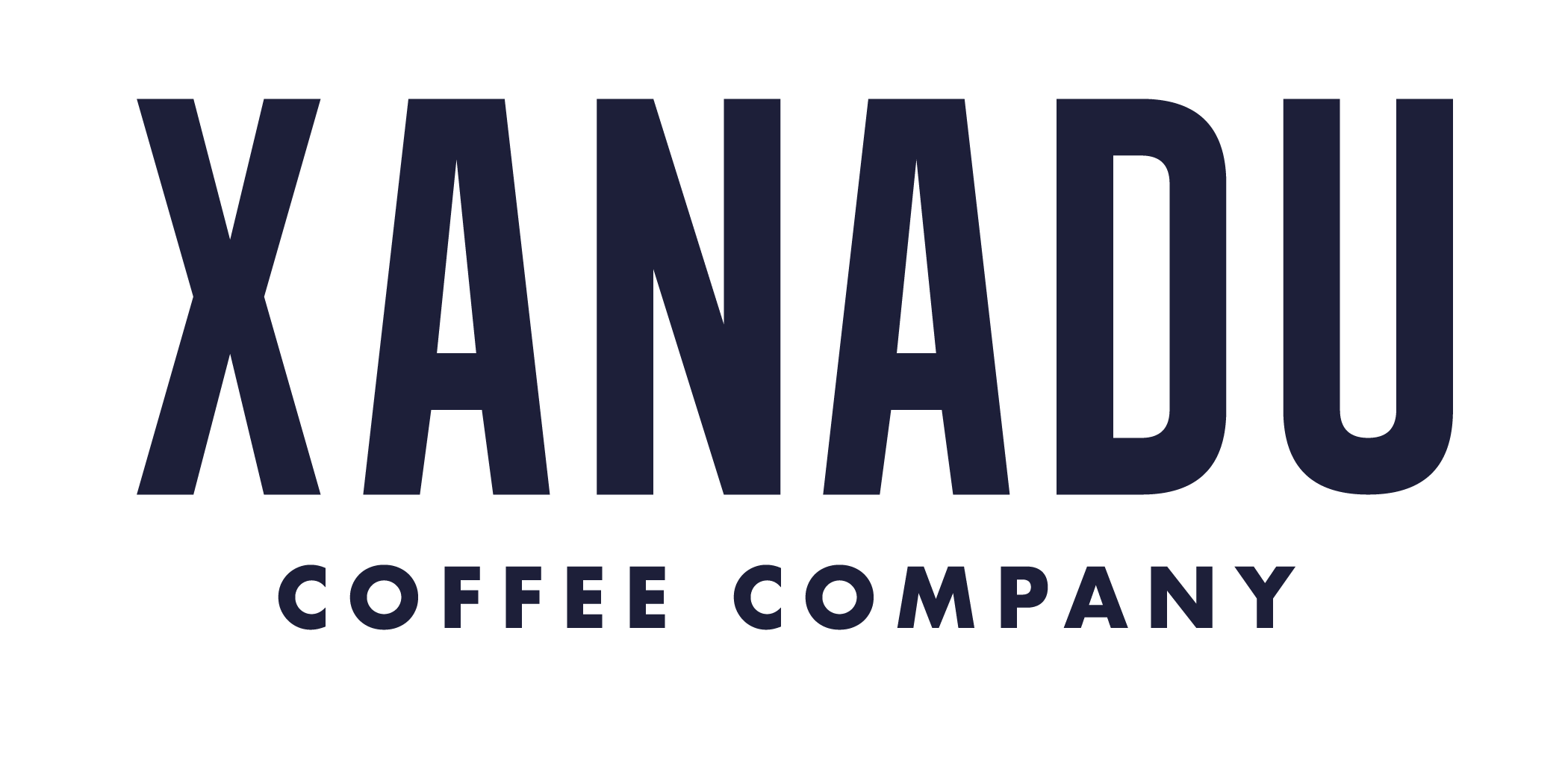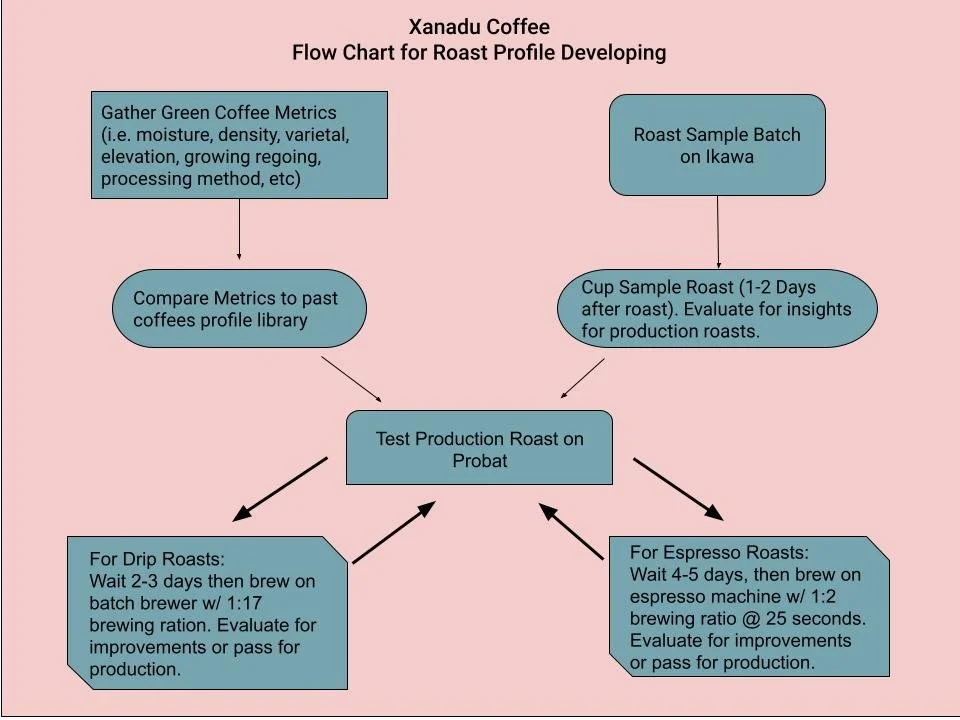Pair Cupworks Roaster Q & A : Part 2 . Roast Profile Development
For the second part of the Cupworks Q & A, I thought it would be a good opportunity to look at roast profile development, at least, how we approach it.
First things first, Disclaimer: I’ve never worked for another roasting company , I’ve never worked in another roasting facility, this is just the way we approach it based on years of experience, trial and error.
Roast Profile Development Flow Chart :
To illustrate our methodology, we are going to be using a new Coffee we have from Nicaragua to move through this chart and to develop a production roast profile.
Gather Green Coffee Metrics :
Farm: Finca Viento del Espiritu Santo
Moisture: 11.4%
Density: 802 g/L
Varietal: Yellow Catuai
Growing Region: Matagalpa, Nicaragua
Processing Method: Washed
Elevation: 1200 m
Compare Metrics to past coffees to find possible profiles in roast library:
For this coffee, we want to use this for our Luminous Drip. This is our flagship medium roast drip coffee. Ideally, the coffee is clean, sweet, balanced with nice berry and stone fruits flavors in cup. Based on the the forward sample, we believe this to be a nice fit for this particular coffee.
Looking back in our library, I was able to find a similar coffee from Honduras, that was used for the same effect from 2021. That coffee was the same varietal, a similar elevation and density and was used for a medium drip as well. This was the profile we chose to use for the first roast .
note: its not the most important thing in the world to pick the most perfect profile for the first test roast, the coffee is going to go through numerous test roasts and evaluations, we just want to start in the right direction. That’s all.
Roast a sample batch on the Ikawa for an initial evaluation:
The Ikawa is an extremely powerful tool for sample roasting and can be used for a number of comparative tests in the roastery. Also, it is a nice way to get an initial impression of the coffee’s potential. However, the roasting the Ikawa does is quite dissimilar to the way the Probat roasts, for that reason we like to use the Ikawa sample roasts to draw general ideas for the production roast, but never for hard metrics ( i.e. finish temp, roasting time, PCD time, etc..)
In roasting and cupping the Nicaragua with the Ikawa, we determined the following :
No issue with scorching, short profiles should be fine to explore.
The Coffee was fairly underdeveloped at a standard sample roast, so we should be careful to develop it fully in our test roasts.
The coffee was even better after a few days of resting, more evidence the ikawa roast did not fully develop it with it’s short and cool standard sample profile. We’re gonna do a few roasts, but I’m feeling like we’ll want something with an end temp over 395 and a PCD that approaches 2 minutes.
Nicaragua Washed Test Production Roast #1
Roast Assessment: As per our earlier inclinations, we chose a Honduras Catuai as our background to roast alongside. To the left we have our first profile. Looking at it now, we dropped at 378f, finished the roast around 10 min, at a temp of 396, and a first crack @ 380 around 8 minutes. All of that looks pretty good, within standard specs for a nice drip so lets so how it tastes on the table.
Brewed results: Very sweet, very clean. The aroma and fragrance were very fruit forward and pleasant. A lot of those notes carried over into the cup and Deacon and I both agreed there were nice plum and blackberry flavors with a very slight spicy/astringent component ( the one negative flavor we found). So far, we are both pretty happy with the results of the first profile.
Nicaragua Washed Test Production Roast #2
Roast Assessment: For the second graph, I wish I could say I knew perfectly what to do after the first tasting and made those adjustments beforehand, however, that’s not really the case. The previous roast tasted pretty good, it was clean, balanced and sweet with enough fruity acidity to please any dedicated coffee drinker, but not so much that I would consider it ‘obnoxious’ or distracting. So.. I just decided to try another that same roast profile, with just a slightly longer maillard phase. Why? Well, because a 3:12 maillard phase is a little on the short side and we know from previous experience that sometimes coffees taste better with a longer maillard phase (3:00 to 4:00 min is an acceptable amount in my experience, and shouldn’t really be shortened or extended beyond those parameters without some clear intention to do so). So, thats what we do. I do not want to extend the entire roast profile, so decide instead to shorten the drying phase and ‘shift’ that time to the maillard phase. We drop it a little bit higher (by a few degrees) and hit it with a bit more gas in the first 2 minutes. The results are shown to the left and in the attached pdf. We do in fact get a very similar profile, except that the drying phase is 25 seconds shorter and the maillard phase is 5 seconds longer, the end temp is essentially the same in time and temperature.
Very. Very. Very. Important note here. Before we even discuss the difference between the two coffees, we need to really really make it clear that it is going to be very tempting to point at these two small differences in dry and maillard phase as the sole result off any discrepancies. In fact, that was kind of the whole point of roasting it slightly different the second time, to get a different result. however, that is just my suspicion and its never ever that clear cut in roasting. There could have been any number of different reasons for differences in taste. The time of day we roasted, the amount of heat in the roaster when we roasted, maybe there were just more ‘defect’ beans were in one of the two batches. So, we are going to move forward using the assumption that the changes we made were the sole resultant of differences between both roasts, just understand that results like are unique and worth repeat experiments to verify (and, we may never know the true answer as to what exactly happened to cause the differences in flavor between the two)
Brewed results: Very nice aroma and fragrance, hard to say if it was better than the previous roast but at least as good and maybe better. The brew was also so good I decided to brew them side by side to try to decide. After trying both, Deacon and I both liked the second brew more than the 1st roast. Pretty much everything about the first roast was true, but just slightly better on the second roast. It was a little sweeter, had a bit more complexity, and had all the nice stone fruit flavors as the first, but with a nice chocolate note added into the mix making it very pleasant. We also didn’t pick up any of the slight spicy/astringent flavor of the first brew.
Nicaragua Washed Test Production Roast #3
Roast Assessment: Well if it worked with the second roast, lets do it again. For this roast, we hit it with a bit more gas out of the gate, this time shrinking the drying phase by 6 seconds and elongating the maillard phase by 15 seconds (compared to the 2nd roast). The end temp, PCD development time and overall roast time all stay relatively the same. For the baristas out there I would compare this to tightening your espresso grind, at some point we are going to cross a line that will result in poorer cup quality. We are tip-toeing our way up to that point as best we can.
Brewed results: With this profile. the cup quality was distinctly worse. The result was almost flat yet very clearly underdeveloped compared to the previous roasts. So much so, I was under the impression a number of quakers snuck their way into the sample brew. So … we did another batch, being very careful to go through the beans, yet the results were the same. (There are a very small number of quakers in this coffee anyways) . It’s pretty rare to underdevelop a coffee just by moving some of the seconds around at the beginning of the roast, but I think we found the lower time limit for the drying phase,
Overall Results
We are moving forward with the second roast profile. As we roast we will naturally create small variations in the roast to try and evaluate, but for the most part, we were both very happy with the results and I want to keep it as close to this profile as possible. I know I got in the weeds a little but with this blog, but without writing a book, I hope I gave you a rough idea of how were approach roasting, and hopefully in this way, we can and will continue to improve upon both the coffees and our understanding or roasts.





